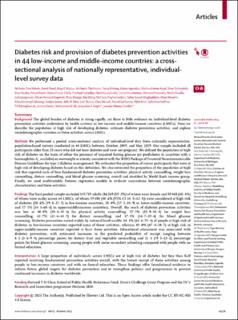| dc.description.abstract | Background
The global burden of diabetes is rising rapidly, yet there is little evidence on individual-level diabetes prevention activities undertaken by health systems in low-income and middle-income countries (LMICs). Here we describe the population at high risk of developing diabetes, estimate diabetes prevention activities, and explore sociodemographic variation in these activities across LMICs.
Methods
We performed a pooled, cross-sectional analysis of individual-level data from nationally representative, population-based surveys conducted in 44 LMICs between October, 2009, and May, 2019. Our sample included all participants older than 25 years who did not have diabetes and were not pregnant. We defined the population at high risk of diabetes on the basis of either the presence of impaired fasting glucose (or prediabetes in countries with a haemoglobin A1c available) or overweight or obesity, consistent with the WHO Package of Essential Noncommunicable Disease Guidelines for type 2 diabetes management. We estimated the proportion of survey participants that were at high risk of developing diabetes based on this definition. We also estimated the proportion of the population at high risk that reported each of four fundamental diabetes prevention activities: physical activity counselling, weight loss counselling, dietary counselling, and blood glucose screening, overall and stratified by World Bank income group. Finally, we used multivariable Poisson regression models to evaluate associations between sociodemographic characteristics and these activities.
Findings
The final pooled sample included 145 739 adults (86 269 [59·2%] of whom were female and 59 468 [40·4%] of whom were male) across 44 LMICs, of whom 59 308 (40·6% [95% CI 38·5–42·8]) were considered at high risk of diabetes (20·6% [19·8–21·5] in low-income countries, 38·0% [37·2–38·9] in lower-middle-income countries, and 57·5% [54·3–60·6] in upper-middle-income countries). Overall, the reach of diabetes prevention activities was low at 40·0% (38·6–41·4) for physical activity counselling, 37·1% (35·9–38·4) for weight loss counselling, 42·7% (41·6–43·7) for dietary counselling, and 37·1% (34·7–39·6) for blood glucose screening. Diabetes prevention varied widely by national-level wealth: 68·1% (64·6–71·4) of people at high risk of diabetes in low-income countries reported none of these activities, whereas 49·0% (47·4–50·7) at high risk in upper-middle-income countries reported at least three activities. Educational attainment was associated with diabetes prevention, with estimated increases in the predicted probability of receipt ranging between 6·5 (3·6–9·4) percentage points for dietary fruit and vegetable counselling and 21·3 (19·5–23·2) percentage points for blood glucose screening, among people with some secondary schooling compared with people with no formal education.
Interpretation
A large proportion of individuals across LMICs are at high risk of diabetes but less than half reported receiving fundamental prevention activities overall, with the lowest receipt of these activities among people in low-income countries and with no formal education. These findings offer foundational evidence to inform future global targets for diabetes prevention and to strengthen policies and programmes to prevent continued increases in diabetes worldwide. | en_US |

